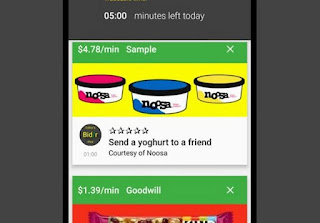As consumers take more control of who they allow into their
viewing space, advertisers will have to be more cognizant of how their ads are
delivered and received. Joe Mandese, Editor-in-Chief of MediaPost, has been working on an initiative called Bid/r which has the potential to
change the ad delivery dynamic.
Charlene Weisler: Over
the next three years, what are the greatest changes facing the ad community?
Joe Mandese: Nigel
Morris, Chief Strategy and Innovation Officer, Dentsu Aegis Network, when asked
the same question a few years ago, said, “The problem is we’ve shifted from an
era of information scarcity to one of information ubiquity.” He meant that
advertising originally evolved in a world of finite media options -- a handful
of newspapers, magazines, TV and radio options -- where big advertisers and
agencies had the leverage of their ad budgets to efficiently buy people’s
attention. If you had enough money you could buy enough reach and frequency to
scale people’s attention.
That started to break down with the explosion of media
options in the 1980s and 1990s thanks to multichannel television. Today,
literally every single human being on the planet is a media channel. The supply
of media options is virtually unlimited. The signal-to-noise ratio between
consumers and brands has grown out of whack, and to paraphrase Nigel Morris,
we’ve shifted from a time when there was a scarcity of media to one when
there’s a scarcity of human attention.
Weisler: What is
Bid/r?
Mandese: Bid/r is
a marketplace where brands can bid directly for a finite supply of the most
valuable consumer attention: attention consumers want to pay to a brand. Users download
a simple app to “list” themselves on an exchange where they receive offers
directly from brands. There is a cap on the amount of “inventory” they can
trade to five minutes daily, because we want both consumers and brands to
understand the scarcity and value of their attention. Consumers are in total
control of their trades and brands only pay when the consumer fulfills 100% of
the terms of the trade.
Brands can offer anything they want to win the user’s
attention: samples, swag, unique experiences, access to media content, even
cash and for any action they want the consumer to complete, not just paying
attention to an ad, but higher order functions like visiting a brand’s site,
downloading information, sampling a product, participating in research,
enrolling in a loyalty program, etc.
From a consumer’s perspective, it’s like Tinder for brands.
They see a feed of potential brands and swipe left or right depending on which
ones they actually want to engage with. From a brand’s point-of-view, they
might be looking to have a first date with a consumer or build a long-term,
lasting relationship.
Weisler: Can the
industry solve for ad blocking? For fraud? For viewability?
Mandese: Of course, but it comes down to defining what the
industry means by “ad blocking,” “fraud” and “viewability.” Depending on how
you define them, all of those problems have always existed for the advertising
industry.
People have always had the ability -- with a few exceptions
-- of controlling what ads they see or not. I used to quip that print media
like newspapers and magazines were the original digital interactive media. If
you saw an ad you didn’t like, you flipped the page. I remember seeing Brian
Monahan (formerly at Walmart and now at Pinterest) present data on TV
commercial zapping and said, “The biggest threat to our TV commercials is not
the DVR, it’s people turning their heads.”
Right now, ad blockers are making it easier to skip ads, but
we’re already seeing a new generation of anti-ad-blockers and even more
recently a generation of anti-anti-ad-blockers. It’s as if the ad industry has
entered into a rapidly escalating arms race with its own consumers.
Same with fraud. We have new jargon like “non-human traffic”
or “non-viewable impressions,” but those behaviors always existed and it was
just a question of how -- and how much -- they happened, not whether they
happened. When I started covering the business, agencies had virtual armies of
ad checkers to handle “discrepancy resolutions” for ads they were being charged
for that never aired or aired in the wrong way. Those problems have always
existed, and if anything, technology has made it easier for brands and agencies
to detect them.
There are a number of promising blockchain technologies that
will likely help, but it’s all premised on advertisers and agencies defining
exactly what they want -- and don’t want -- and communicating it clearly as
part of their contracts with the media.
Weisler: What metrics
do you think are the most important indicator of a successful ad campaign?
Mandese: It comes
down to what a brand and agency are trying to achieve with their ad campaign.
It can be multiple things -- exposure, engagement, action, etc. -- but
ultimately, they have to focus on one key indicator they use to measure
performance.
I’m a big fan of time-spent and duration metrics, not just
because it’s what Bid/r is premised on, but because I think it’s the best way
to measure if a user was actually engaged with the ad campaign. What that
duration should be, is up to different stakeholders -- brands, agencies, media,
and yes, even consumers -- to hash out, but I think the time of using simple
impressions or exposure-based metrics is over.
I think the Media Rating Council’s (MRC’s) new “digital
audience-based measurement standards,” and the fact that they are
duration-weighted, is a step in the right direction, because it creates an even
playing field for all stakeholders participating in a measurement method that
they all agree to. But ultimately, they have to agree about what they’re
agreeing to measure.
This article first appeared in www.MediaVillage.com
Note: Jack Myers and Charlene Weisler are both investors
in Bid/r. Joe Mandese was the editor of The Myers Report newsletter,
the forerunner to MediaVillage.

No comments:
Post a Comment